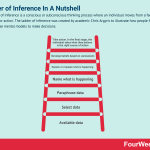Ladder of Inference In A Nutshell

The ladder of inference is a conscious or subconscious thinking process where an individual moves from a fact to a decision or action. The ladder of inference was created by academic Chris Argyris to illustrate how people form and then use mental models to make decisions.
Understanding the ladder of inference
Mental models encapsulate assumptions and generalizations and are unique to everyone. They explain why two people can witness the same event but experience it in two vastly different fashions.
Fundamentally, the ladder of inference encourages informed decision making based on fact and not on personal biases that characterize mental models.
By acting without bias, the individual or business experiences growth. Indeed, the ladder is often equated with the cycle of growth, where completion of each cycle results in improvement based on continuous learning.
Climbing the rungs of the inference ladder
The ladder of inference can be thought of as a visual representation of the decision-making thought process.
Seven rungs exist, with each rung representing one of the seven stages of thinking.
Let’s look at each stage:
Stage 1 – available data. At the bottom of the ladder exists information about the reality and facts of daily life. This includes everything from the body language of a colleague to the results from a marketing campaign. Stage 2 – select data. Given the richness and abundance of available data, people cannot pay attention to all of it simultaneously. Instead, mostly subconscious choices are made regarding what data is selected and what data is ignored.Stage 3 – paraphrase data. In the third stage, the individual adds meaning to the data based on unique past experiences, values, beliefs, or biases. Often, there is no consideration regarding whether the meaning applied is valid or true.Stage 4 – name what is happening. Here, the individual names the situation based on a combination of interpreted fact and personal assumptions.Stage 5 – explain or evaluate what is happening. Having just explained what is happening, the individual then seeks to explain why it is happening. This is performed by considering a list of causal theories that are judged as either good or bad according to the individual’s values.Stage 6 – develop beliefs based on conclusions. These beliefs then shape future judgments in scenarios with similar contexts. The classic example is an employee who is consistently late to work in the belief that they will not be reprimanded by management. This belief then leads the employee to be late to meetings and other formal engagements.Stage 7 – take action. In the final stage, the individual takes what they believe is the right course of action. Of course, their actions are always based on beliefs and assumptions.
Using the ladder of inference to make better decisions
Many assume that the ladder of inference is a systematic guide to making better decisions. However, the ladder merely outlines the natural thought process that every individual experiences.
To improve decision making, an individual must know where they sit on the ladder and adjust accordingly. Perhaps counterintuitively, it is preferable to occupy the lower rungs of the ladder or descend where possible.
An individual who tends to paraphrase data (Stage 3) to their detriment should be more selective about the data they select from their environment (Stage 2). An individual who tends to select data to suit their own agenda (Stage 2) should consider incorporating a broader subset of available data (Stage 1).
In both cases, the individual is encouraged to question the validity of their assumptions and beliefs. This helps them break free of the reflexive loop – where assumptions and beliefs impact the data that will be selected in similar future scenarios. This can often lead to a toxic cycle where actions are reinforced by limited or flawed information and vice versa.
Key takeaways
The ladder of inference describes how people form and sustain mental models in the decision-making process.The ladder of inference has seven rungs, with each rung representing a particular stage of decision making based on personal assumptions, beliefs, or biases.The ladder of inference is not intended to provide advice on optimal decision making. Instead, it allows individuals to identify where their process is flawed and move down the ladder to correct it.
Read Next: Biases, Bounded Rationality, Mental Models.
Main Guides:
Business ModelsBusiness StrategyMarketing StrategyBusiness Model InnovationPlatform Business ModelsNetwork Effects In A NutshellDigital Business Models
The post Ladder of Inference In A Nutshell appeared first on FourWeekMBA.



